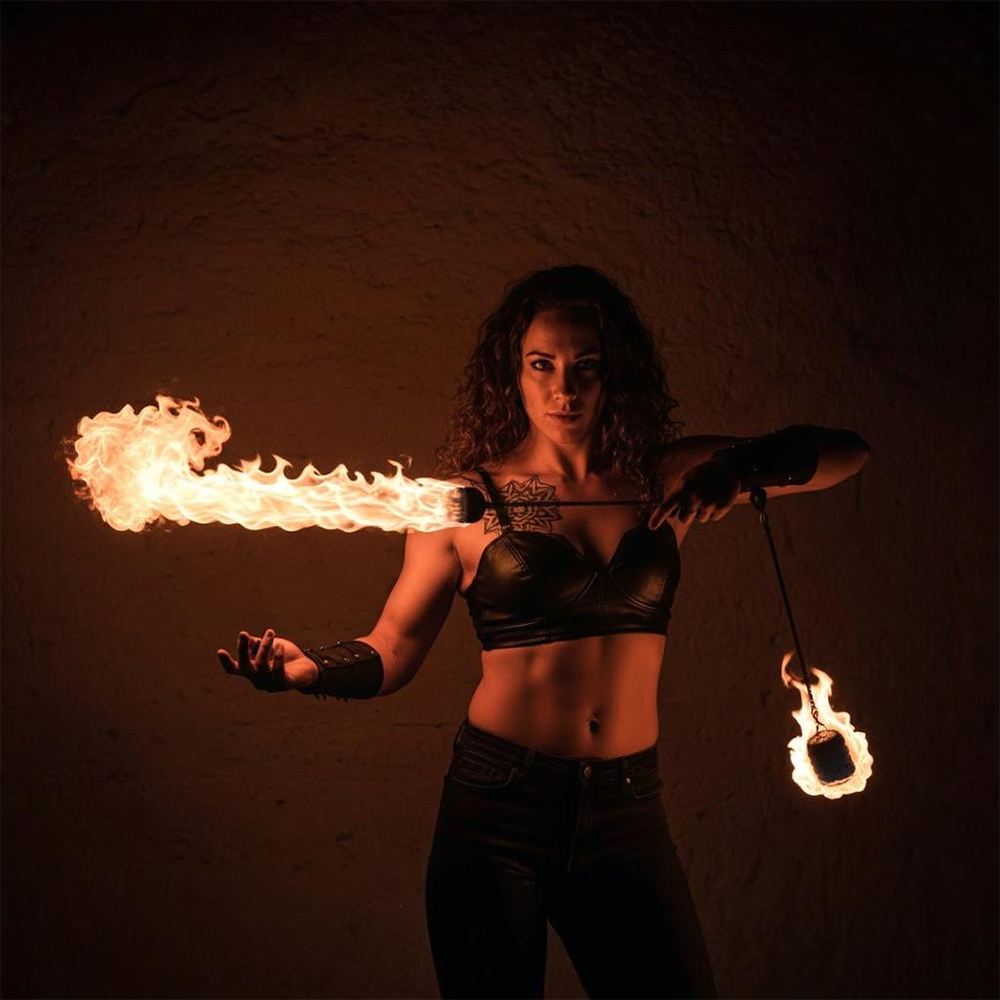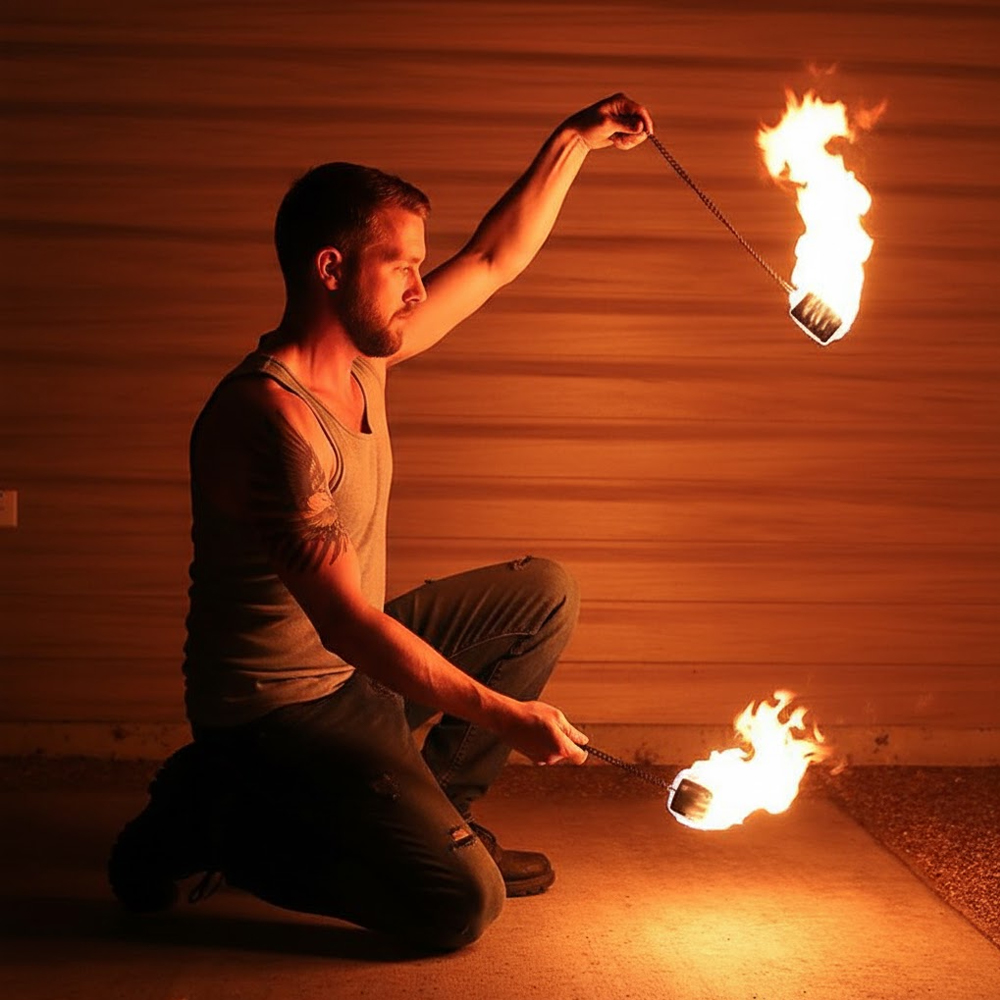1. Introduction to Fire Poi Safety
Spinning fire poi is one of the most captivating forms of flow arts—it commands attention, admiration, and often a healthy dose of awe. But behind every smooth routine and fiery orbit lies a vital truth: safety isn’t optional; it’s foundational. Whether you’re a casual spinner at backyard gatherings or a seasoned performer on festival stages, mastering safety is what ensures that the thrill of fire stays magical instead of turning dangerous.
I remember the first time I attended a fire jam. The atmosphere was electrifying, and watching performers gracefully move with fire lit a passion in me. But what struck me just as much was the ritual of safety—people checking each other’s gear, having extinguishers ready, even calling out their lighting and extinguishing. That moment made it clear: real performers take fire seriously.
In this comprehensive guide, you’ll learn every aspect of fire poi safety—from choosing gear to emergency procedures—blended with practical advice to keep both you and your audience safe.

2. Preparing Your Practice and Performance Space
The setting can either enhance your show or turn it into a hazard zone. Fire demands space, planning, and control.
Key Considerations:
- Surface: Always perform on non-flammable, even ground. Concrete, sand, or short grass work best.
- Wind: Light wind can be manageable, but anything above 10 mph increases unpredictability. Avoid spinning in gusty conditions.
- Fuel Station: Keep your dipping station well away (at least 10-15 feet) from the ignition area.
- Safety Zone: Use clear markings like cones or lights to establish a safety perimeter.
- Emergency Access: Ensure clear paths for exiting, emergency vehicles, or access to water/extinguishers.

During my first solo show, I underestimated how close the audience would crowd in. I learned fast: now I rope off a 10-foot safety radius and have my fire safety announce it before I even light up. It keeps everyone comfortable—and covered.
3. Essential Gear for a Safe Fire Poi Show
Your poi tools aren’t the only things you should think about. Safety equipment is just as critical as the props themselves.
Must-Have Equipment:
- Kevlar-Wick Poi Heads: Non-fraying, designed for fire.
- Quick-Release Handles: For easy drop in emergencies.
- Dampening Towels or “Fire Blankets”: For smothering flames if needed.
- Dipo Cans & Spin-Off Containers: To control excess fuel.
- Fire Extinguisher: At least one Class B extinguisher.
- Safety Kit: Including aloe gel, burn cream, scissors, and gloves.
Safety isn’t just what’s on you—it’s around you. I always bring two extinguishers: one near me, and one in the hands of my spotter. Redundancy can be life-saving.

4. Fuels: Types, Handling, and Precautions
The choice of fuel affects the flame’s size, color, and burn duration—but more importantly, it determines your level of risk.
Common Fuels:
| Fuel Type | Flash Point | Burn Duration | Visibility | Smell |
|---|---|---|---|---|
| Lamp Oil | 93°C (200°F) | Long | Moderate | Mild |
| White Gas | -20°C (-4°F) | Short | Very bright | Strong |
| Kerosene | 38°C (100°F) | Medium | Moderate | Oily |
Fuel Handling Tips:
- Store in clearly labeled, sealed containers.
- Never use gasoline or alcohol-based fuels.
- Always dip poi over a metal container and spin off excess far from ignition points.
- Wear nitrile gloves when handling fuel.
One spinner I knew once neglected to properly spin off their poi and lit up too close to the fuel station—the whoosh and panic that followed were unforgettable. Don’t cut corners.
5. Ignition and Extinguishing Procedures
Lighting up isn’t just theatrical—it’s technical. Each step should be intentional.
Ignition Best Practices:
- Always announce: “Lighting up!”
- Use a long lighter or torch—not matches or short lighters.
- Only ignite in clear wind conditions.
- Never light poi near your body.
Safe Extinguishing:
- Let poi burn out naturally in a safe clearing.
- If needed, extinguish with a damp towel by covering and smothering—never stomp on them.
- Have a designated fire safety person with a blanket ready at all times.
When I first lit up, I had a trained friend act as my spotter. Having someone with a wet towel ready and their eyes locked on me gave me the confidence to perform—and the safety net if things went wrong.
6. Performer’s Clothing and Personal Protection
Your costume should never be a liability. Looks matter—but safety comes first.
Clothing Guidelines:
- Natural fibers only (cotton, leather, wool). No synthetics.
- Avoid loose, flowy fabric—tight-fitting is safer.
- Cover skin when possible: long sleeves, pants, closed shoes.
- No hair spray or makeup with alcohol content.
For my fire gigs, I have a custom cotton outfit and use a leather arm guard. It’s practical and stylish—and fire resistant.
Hair Safety:
- Tie back all hair tightly.
- Apply a damp cloth wrap or use a fire-resistant head cover.
- No flammable products (gels, sprays).
7. Emergency Protocols and What to Do When Things Go Wrong
No matter how prepared you are, things happen. The question is: do you know what to do when they do?
Your Emergency Plan Should Include:
- A trained fire safety assistant—always.
- Access to water and a fire extinguisher.
- Stop-Drop-Roll knowledge for all performers.
- Clear evacuation routes.
One time, during a group routine, a friend’s poi wick frayed and lit unevenly. We had to stop mid-performance—but because we’d rehearsed safety drills, the show stopped smoothly, the fire was out in seconds, and nobody panicked.
8. Advanced Considerations: Sparkly Poi and Steel Wool Safety
Steel wool poi is stunning—but exponentially more dangerous.
Special Risks:
- Throwing Sparks: Can ignite clothing, grass, and plastic.
- Hot Embers: Remain active after burnout.
- Visibility: Often spun in dark, remote locations.
Specific Safety Measures:
- Wear goggles and gloves.
- Use larger safety perimeters—up to 20 feet.
- Have multiple extinguishers on hand.
- Always scout terrain for flammable debris.
I tried steel wool poi exactly once. The thrill? Incredible. But after a near-miss with a flying ember and my cotton hoodie, I’ve stuck to LED or standard wicks since.
9. Audience Safety and Managing the Surrounding Environment
You’re not just responsible for yourself—you’re responsible for everyone watching.
Pro Performer Practices:
- Announce a 10-foot minimum audience distance.
- Rope or cone off your performance area.
- Have a verbal spotter to warn audience of danger.
- Never spin near dry vegetation or hanging wires.
In public shows, I often enlist a friend to play “security.” They explain to the audience where they can stand and what to expect. Their presence alone prevents 90% of boundary issues.
10. Safe Storage and Maintenance of Fire Equipment
Proper care of your tools prolongs their life and keeps them safe for reuse.
Storage Tips:
- Store fuel in metal containers, away from sunlight.
- Keep poi heads dry and clean—no fraying or unraveling.
- Clean gear after every use with mild soap and water.
- Hang poi from a rack to dry.
I’ve seen what moldy, fuel-soaked poi heads can do—they degrade fast and catch fire unevenly. That’s why I clean and hang mine every single time.
11. Final Tips for Practicing and Performing with Fire Poi
At its heart, spinning fire poi is about art, adrenaline, and respect. Respect the flame, and it will reward you with unforgettable experiences.
Final Checklist Before Spinning:
✅ All gear inspected
✅ Fuel station established
✅ Fire extinguisher and wet towels in place
✅ Spotter trained and ready
✅ Audience area marked
✅ Wind and weather conditions checked
✅ Announce ignition loudly
And above all: practice without fire before adding fuel. Get your routine muscle-perfect in daylight before ever lighting up.
Conclusion
Fire poi isn’t just a performance—it’s a responsibility. Whether you’re just starting out or you’ve dazzled audiences for years, one truth remains: you never outgrow the need for safety.
Through mindful preparation, proper gear, and rigorous protocols, you can ensure that your performances remain powerful, inspiring, and—most importantly—safe. Spin smart, burn bright.